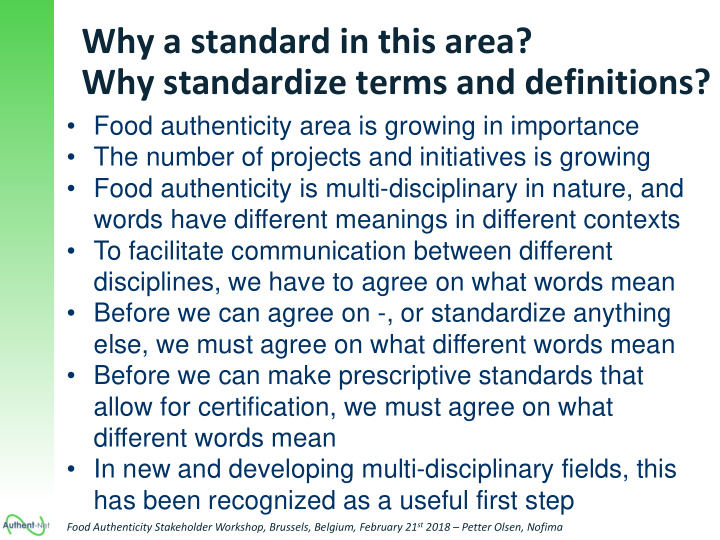



Why a standard in this area? Why standardize terms and definitions? • Food authenticity area is growing in importance • The number of projects and initiatives is growing • Food authenticity is multi-disciplinary in nature, and words have different meanings in different contexts • To facilitate communication between different disciplines, we have to agree on what words mean • Before we can agree on -, or standardize anything else, we must agree on what different words mean • Before we can make prescriptive standards that allow for certification, we must agree on what different words mean • In new and developing multi-disciplinary fields, this has been recognized as a useful first step Food Authenticity Stakeholder Workshop, Brussels, Belgium, February 21 st 2018 – Petter Olsen, Nofima
Authent-Net CWA process 1. Business plan produced and distributed 2. Open kick-off meeting announced, invitations sent May 10 th 2017, CWA kick-off meeting in Parma 3. 4. At meeting – outline CWA content 5. At meeting and after – get initial input 6. Dec 2017, distribute first draft of CWA in internal group (done) 7. Dec 2017 – Feb 2018, first hearing process, internal (now) 8. Feb 2018, make updated version (upcoming) 9. Feb 2018 – Mar 2018, second hearing process, open 10. March 22 nd 2018, consensus meeting in Brussels 11. Get final input, make final version 12. Mar/Apr 2017 – make final version of CWA, submit to CEN Food Authenticity Stakeholder Workshop, Brussels, Belgium, February 21 st 2018 – Petter Olsen, Nofima
Some key terms under discussion (food product) characteristic A distinguishing feature of the (food) product Note 1 to entry: A product characteristic can be qualitative or quantitative Note 2 to entry: A product characteristic can be inherent in the product itself, or it can relate to the conditions under which the product was produced, or the environment it was produced in Note 3 to entry: A product characteristic is sometimes referred to as a product attribute or a product property All definitions and notes are from the first draft version; will be updated Food Authenticity Stakeholder Workshop, Brussels, Belgium, February 21 st 2018 – Petter Olsen, Nofima
Some key terms under discussion Note 4 to entry: There are various classes of product characteristics, such as the following: • physical (e.g. mechanical, electrical, chemical or biological characteristics) • sensory (e.g. related to smell, touch or taste) • functional (e.g. medicinal quality of a food product) • related to origin (e.g. raw material used, identity of primary processor) • related to processing or production method (e.g. mildly processed, cooked at low temperature, halal production, kosher production) • related to standards, defined practices, certification schemes or regulations (e.g. produced according to some specification). This characteristic is normally connected to other specified product characteristics that must be present or absent or have some particular value. Food Authenticity Stakeholder Workshop, Brussels, Belgium, February 21 st 2018 – Petter Olsen, Nofima
Some key terms under discussion (food product) claim A statement where a (food) product is said to have a certain characteristic Note 1 to entry: The claim can be explicit, e.g. on the label or in the accompanying documentation, or it can be implicit, in that if the food product had the characteristic in question, it should have been stated explicitly. Note 2 to entry: A product claim is sometimes referred to as a product description. Food Authenticity Stakeholder Workshop, Brussels, Belgium, February 21 st 2018 – Petter Olsen, Nofima
Some key terms under discussion (food product) authenticity A match between the actual food product characteristic and the corresponding food product claim; when the food product actually is what the claim says that it is (food product) authentication The process of verifying the accuracy and correctness of the match between the food product characteristic and the corresponding claim Food Authenticity Stakeholder Workshop, Brussels, Belgium, February 21 st 2018 – Petter Olsen, Nofima
Some key terms under discussion (food product) misdescription A mismatch between the actual food product characteristic and the corresponding food product claim Note 1 to entry: Food product misdescription can be deliberate or accidental Note 2 to entry: Misdescription on the label of a food product is often referred to as mislabelling, but the term mislabelling is also used to refer to when the label is not in accordance with relevant requirements or regulations. If the consumer product was a cod fillet and label just said “fish”, that would not be a misdescription, but it would most likely be a violation of the labelling requirements that normally require the species to be explicitly specified on commercial labels. Food Authenticity Stakeholder Workshop, Brussels, Belgium, February 21 st 2018 – Petter Olsen, Nofima
Some key terms under discussion Note 3 to entry: Common types of misdescription or mislabelling include: • When the stated geographical origin, species, or method of production or storage does not match the actual product characteristic • When processes that should have been declared (e.g. irradiation, freezing) were used when making the product, and not declared • When the stated production date does not match the actual production date • When the stated best before date, use by date, or expiration date does not match the respective dates calculated by the producer, using their normal methods • When the stated ingredient is not the actual ingredient • When the amounts stated for the ingredients do not correspond to the actual ingredient amounts used • When ingredients or adulterants that should have been declared (e.g. water, starch) were added to the product, but not declared Food Authenticity Stakeholder Workshop, Brussels, Belgium, February 21 st 2018 – Petter Olsen, Nofima
Recommend
More recommend